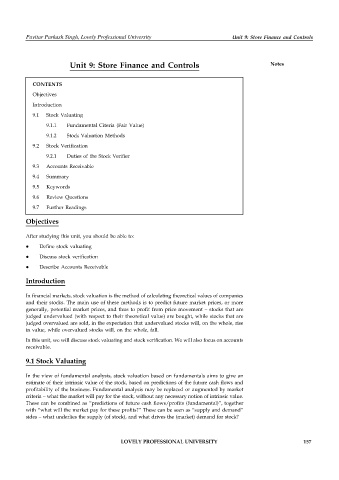Page 162 - DMGT553_RETAIL_STORE_MANAGEMENT
P. 162
Pavitar Parkash Singh, Lovely Professional University Unit 9: Store Finance and Controls
Unit 9: Store Finance and Controls Notes
CONTENTS
Objectives
Introduction
9.1 Stock Valuating
9.1.1 Fundamental Citeria (Fair Value)
9.1.2 Stock Valuation Methods
9.2 Stock Verification
9.2.1 Duties of the Stock Verifier
9.3 Accounts Receivable
9.4 Summary
9.5 Keywords
9.6 Review Questions
9.7 Further Readings
Objectives
After studying this unit, you should be able to:
Define stock valuating
Discuss stock verification
Describe Accounts Receivable
Introduction
In financial markets, stock valuation is the method of calculating theoretical values of companies
and their stocks. The main use of these methods is to predict future market prices, or more
generally, potential market prices, and thus to profit from price movement – stocks that are
judged undervalued (with respect to their theoretical value) are bought, while stocks that are
judged overvalued are sold, in the expectation that undervalued stocks will, on the whole, rise
in value, while overvalued stocks will, on the whole, fall.
In this unit, we will discuss stock valuating and stock verification. We will also focus on accounts
receivable.
9.1 Stock Valuating
In the view of fundamental analysis, stock valuation based on fundamentals aims to give an
estimate of their intrinsic value of the stock, based on predictions of the future cash flows and
profitability of the business. Fundamental analysis may be replaced or augmented by market
criteria – what the market will pay for the stock, without any necessary notion of intrinsic value.
These can be combined as “predictions of future cash flows/profits (fundamental)”, together
with “what will the market pay for these profits?” These can be seen as “supply and demand”
sides – what underlies the supply (of stock), and what drives the (market) demand for stock?
LOVELY PROFESSIONAL UNIVERSITY 157

